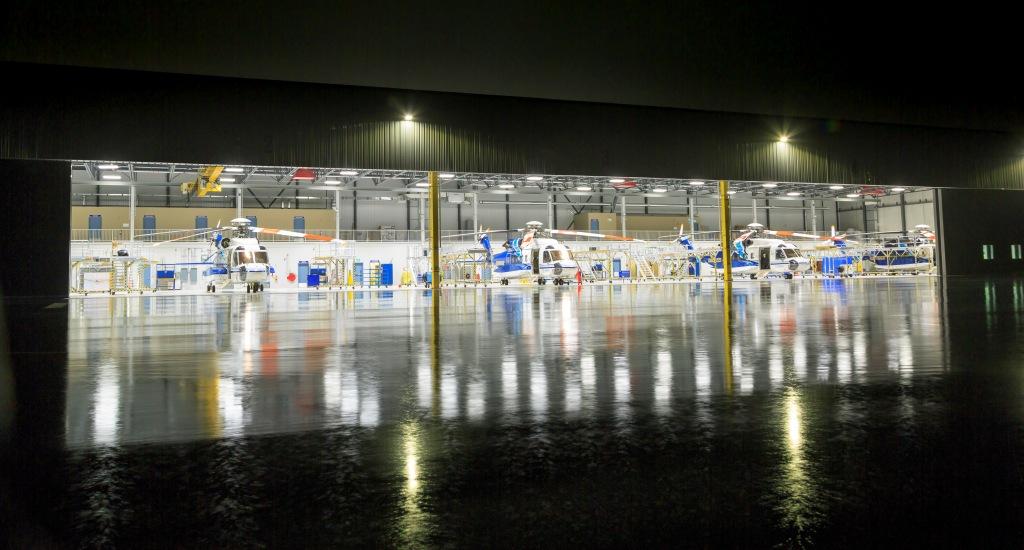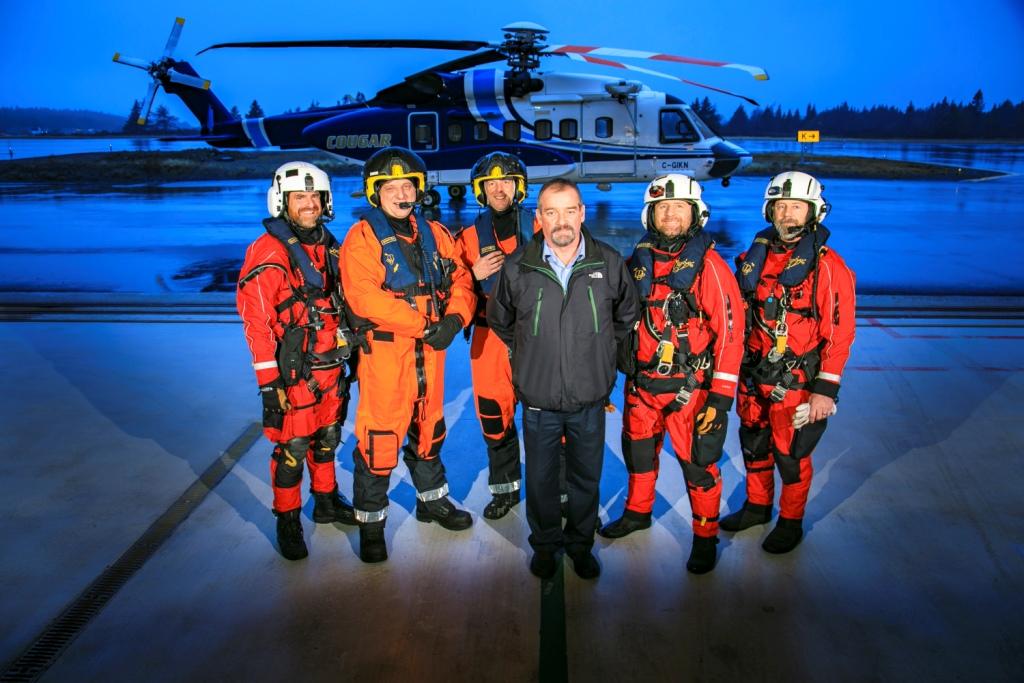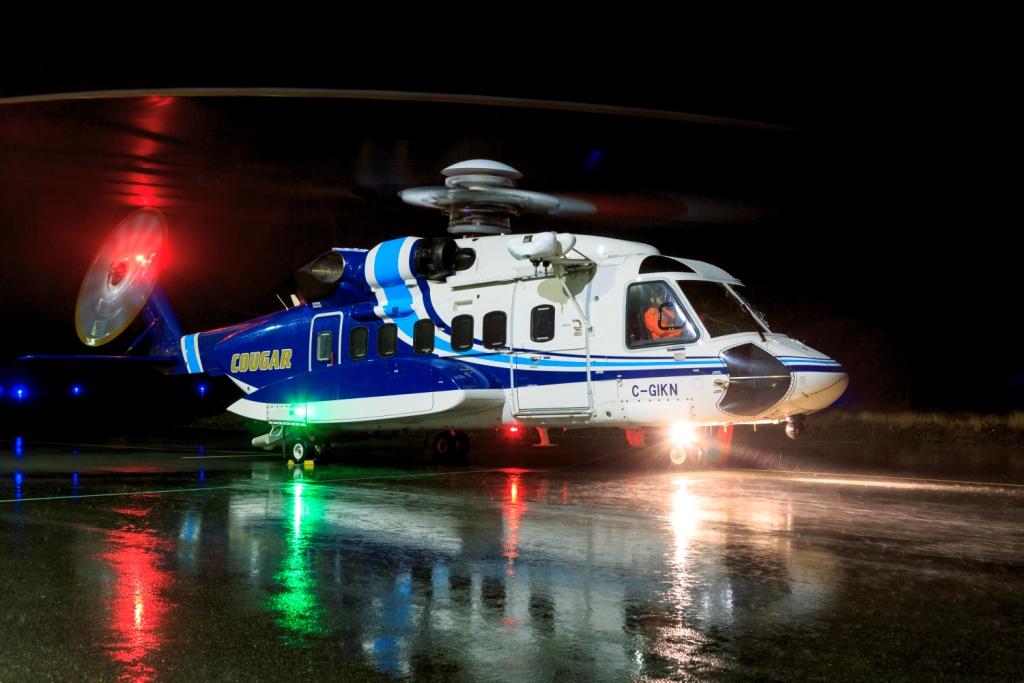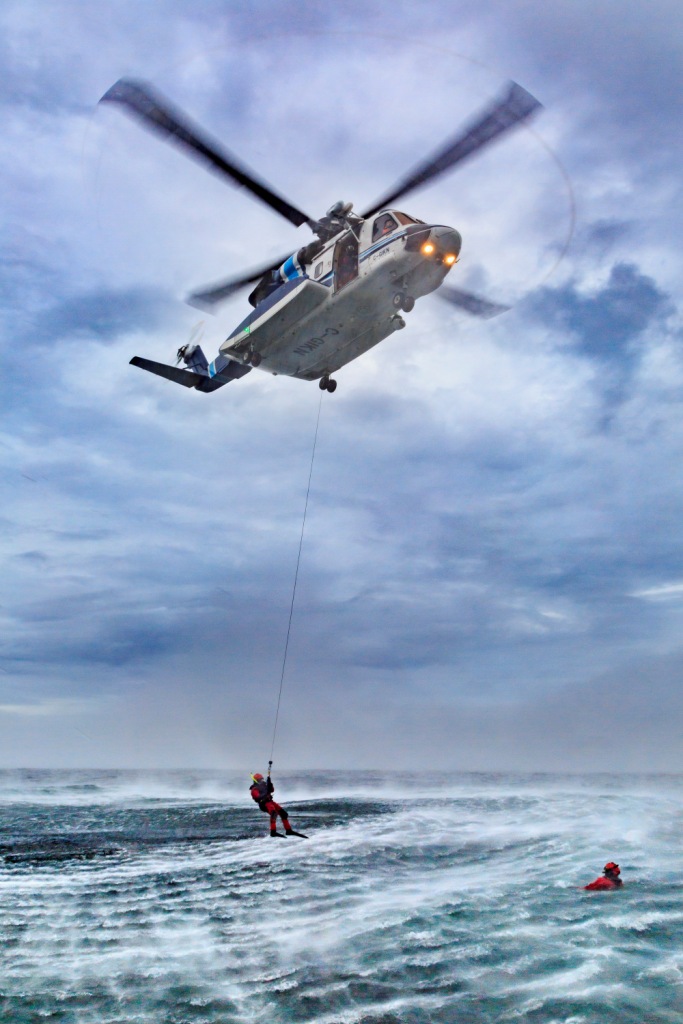COUGAR HELICOPTERS
Situated on the shores of the rugged North Atlantic in St. John's, Newfoundland & Labrador,
Cougar Helicopters occupies a 17 acre footprint at St. John's International Airport consisting
of three facilities and ramp space.
 Cougar's origins go back to 1984 when it was founded in Halifax, Nova Scotia to provide shuttle service to/from the airport. The company entered the offshore oil and gas industry in 1991.
Cougar's origins go back to 1984 when it was founded in Halifax, Nova Scotia to provide shuttle service to/from the airport. The company entered the offshore oil and gas industry in 1991.
When Cougar was awarded the support services contract for Hibernia Management & Development Company (HMDC) in 1995, it relocated its head office and constructed a new heliport, hangar and office complex in St. John's, Newfoundland & Labrador.
The VIH Aviation Group of Victoria, British Columbia, whose roots date back to 1955, purchased Cougar Helicopters from its original owner in 2003 and it was a natural fit. "Together with VIH's existing helicopter and fixed wing operations, aircraft maintenance capabilities, component repair and overhaul, and aerospace manufacturing capabilities, Cougar is uniquely positioned to offer a full-service capability solution from coast-to-coast-to-coast,” Ken Norie, VIH President and CEO, told CDR.
In 2011, Cougar opened the Halifax Heliport to support operations in its founding city. A year later, a built-for-purpose SAR (search and rescue) facility was launched in St. John's where all aspects of a full-service SAR provider are offered. In 2016, the company relocated from its original 1995 facility to a new 51,000 sq. ft. heliport and adjacent hangar at St. John’s International Airport.
PROVIDING SAR SERVICES 24/7, 365 DAYS A YEAR
Typically, articles that profile Cougar Helicopters will focus on the company’s reliable, consistent air service for the offshore oil & gas industry. However, this article may be different as here we want to spotlight Cougar’s fully-equipped, professionally staffed, SAR program that operates 24/7, 365 days a year. It is based at a 27,500 square foot hangar dedicated to SAR operations, at the company’s airport facilities in St. John’s, Newfoundland.
Cougar Helicopter’s SAR program is a recognized world leader in harsh weather search and rescue because of its team of experienced professionals, its safety culture and its innovation in the industry. ‘Always performing to the highest standards’ is the philosophy that guides this Canadian company’s operations.
To ensure 24/7 SAR service to its customers, Cougar rotates a 27-member team of experienced pilots and rescue specialists (rescuemen/hoist operators) at its SAR hangar. The team members serve on a 21 on/21 off work rotation, ready to provide emergency response services to individuals on offshore oil & gas platforms and ships.
The company’s aircraft of choice is the proven Sikorsky S92 helicopter, one of 33 dedicated S92s operating around the globe in support of SAR services. Cougar’s aircraft is equipped with the very latest in SAR and aerial search technology. (more on that below).
As a backup, one of Cougar’s passenger configured S-92s has been upgraded to replicate the SAR aircraft’s rescue/medical capabilities.
When the primary SAR aircraft undergoes required maintenance, the backup aircraft fills the gap. This maintenance is performed by a team of aircraft maintenance engineers (AMEs) assigned to the SAR facility. To ensure the best possible service, Cougar’s SAR team is dispatched by the company’s 24/7 Operational Control Centre (OCC). All of Cougar’s flights are planned, supported and satellite-tracked here using a Transport Canada-certified Type B Coauthority flight dispatch system. In this system, decisions are made jointly by the Flight Dispatcher and the Pilot-in-Command, to provide an enhanced level of flight safety.
 FLYING THE S-92 FOR SAR
FLYING THE S-92 FOR SAR
Cougar Helicopters commenced passenger transportation and search and rescue services to the Canadian offshore oil and gas industry in 1997. Originally this service was provided by the AS332L1 Super Puma with the S-92 being introduced in 2005 in a Lim SAR capacity. In 2009, the company acquired an S-92 specifically for SAR and hired additional pilots and rescue specialists. This was followed in 2012 with the construction and opening of Cougar’s purpose-built SAR facility. “Cougars personnel work in a culture of continuous improvement, which flows into Cougar's operational SAR capabilities and safety systems.” Rick Banks, Cougar’s SAR Program Manager, told CDR. “This is why we developed a ‘firehall model’ facility for our SAR operations, to allow the team to quickly respond in a timely and safe manner. It is also why we have added upgrades such as Automatic Approach to Hover, All Weather Auto Hover and Night Vision capability to our primary and secondary SAR S-92s, so that our SAR team can be as effective as possible during rescue missions.”
Cougar’s SAR capability is built on fast response. When the emergency alarm is activated at the company’s SAR hangar, the on-duty flight crew of five (two pilots and three rescue specialists) fly into action as soon as possible. Cougar's well practiced procedures allow for it's SAR team to take off within 20 minutes of the alarm being sounded.
FAST RESPONSE TIMES
To meet this ambitious target, the SAR hangar was designed in consultation with the end user and was built to enable efficient and rapid deployments. For instance, the hangar is deep enough to enable a tow vehicle to remain attached to the aircraft at all times.
Thanks to regular drills, Cougar’s SAR team is shaving time off the 20 minute limit. “We’re averaging about 13-15 minutes to wheels up,” said Hank Williams, COO of Cougar Helicopters.
To put safety first, Cougar’s SAR operation adheres to Transport Canada-approved Operations Manual and Standard Operating Procedures (SOPs) specifically written for these kind of operations. The company’s manual and SOPs are qualitatively comparable to military SAR standards and procedures.
“The RCAF’s SAR standards and procedures are among the very best in the world, so for inter-operability missions, it only makes sense that Cougar base its procedures on them” said Williams to CDR. “The Canadian military has one of the best search & rescue capabilities in the world,” said Cougar SAR Rescue Specialist Darren Darbyson. “Their people perform all kinds of difficult SAR missions, and gain all kinds of useful experience as a result. We tap into this experience when they leave the military and come to work for us.”
Worth noting: Such is the quality of Cougar’s SAR operations, that this unit is tasked periodically by the Joint Rescue Coordination Center (JRCC) in Halifax, to aid in rescue missions all along the east coast and eastern Arctic region.
THE RIGHT EQUIPMENT FOR THE JOB
To meet the highest standards for helicopter-based SAR, you need the right equipment. Cougar has met this mark by selecting the highly capable Sikorsky S-92. “Our SAR S-92 is fully-equipped and state-of-the-art,” SAR Base Lead Pilot Pat Perry, told CDR. “I can’t think of a better machine to fly for challenging SAR missions.”
Among the SAR S-92's many capabilities are a 30-million candle power Spectrolab Nightsun searchlight. This blazingly-bright light can be ‘slaved’ to the helicopter’s FLIR Ultra 8500XRT forward-looking infrared camera and its control system. As a crew member moves the FLIR camera to search the rescue scene, the Nightsun’s searchlight illuminates the target.
The SAR S-92's night vision goggles (NVGs) and night vision-compatible cockpit help everyone see ‘in the dark’. Meanwhile, the aircraft’s wireless communications eliminate restrictive cables; supporting two-way conversations even when one or more of the crew members are outside the helicopter.
As mentioned above, the SAR S-92 has an Automatic Flight System that allows the helicopter to auto-transition to altitudes as low as 80', then auto-hover above the ground/water without direct pilot intervention. This frees the pilot to do other tasks; preventing pilot sensory overload and overwork in demanding situations.
As well, the SAR S-92 has a ‘crew hover control’ that allows the hoist operator to fine-tune the helicopter’s position in the air, while leaving full control to the pilots. This feature reduces the amount of back-and-forth conversation between the two sides during hoist operations and allows everyone to focus on their respective jobs. The result is more accurate hoisting and safer flight control.
REDUNDANCY FOR ADDED SAFETY
For redundancy’s sake, the SAR S-92 has a Goodrich dual rescue hoist system. “The two hoists work independently of each other,” said Darbyson, “… so if one hoist fails, the other one is still ready to go.” Equipped with 300' of usable cable, the hoist is rated for 600 lbs. but can carry up to 1,100 lbs. in a temporary overload situation. Slip-on rescue slings, a rescue basket and a Stokes litter for stretcher-style patients can all be attached to the hoist cable.
“If both hoists fail, we have two 10-man inflatable life rafts that can be dropped into the water for survivors,” Darbyson said.
“They provide shelter and necessary supplies until the rescue can be completed.”
Medically, Cougar’s SAR aircraft is as well-equipped as any modern air ambulance. It has a, a defibrillator, patient monitors and oxygen tanks; plus triage and supplementary medical kits to support a wide range of advanced lifesaving protocols.
“The S-92 is very spacious inside,” said Darbyson. “This gives rescue specialists such as myself lots of room to work, and provides space for additional SAR components as needed.”
HIGHLY TRAINED STAFF
Collectively, Cougar’s SAR team members come from diverse backgrounds; including civilian and military SAR, flight paramedicine, safety and advanced medical systems and survival instruction. In addition to their offshore aerial experience, the company’s SAR personnel also have extensive Arctic and ship-borne operational experience.
The company’s SAR pilots are seasoned veterans who understand how to fly in the worst of North Atlantic weather. Add the fact that they are flying the sophisticated S-92, and these pilots have what they need to execute SAR missions safely and effectively.
Cougar’s well-trained Rescue Specialists are more than prepared to deal with a multitude of injuries and illnesses. To boost their skills, a specialized in-house paramedic training program is offered by the company. It is backed by a Medical Director, detailed medical directives, and 24/7 online medical assistance to aid Cougar’s Rescue Specialists on the job.
“Whether it’s airway control, chest needle decompression, intravenous/intraosseous infusions, or a drug box containing medications for pain, symptom relief and acute care, Cougar’s medical teams have the skills and the tools to do the job,” said Banks. “Coupled with an intensive nine-step currency program that includes an annual visit to the high fidelity medical sim bay and cadaver lab in Halifax, Nova Scotia, the injured or sick are in capable hands.”
All of these SAR professionals practice constantly to deploy quickly. This is why every Cougar SAR team member knows precisely what their role is when the emergency alarm is activated.
When Cougar’s SAR team is not in action, they are drilling to cope with a range of rescue scenarios. “These exercises are carried out just as seriously as the real thing,” Banks said. “We do drills twice a month with no notice, so the crews don’t know if they are going to an actual incident or not.”
WORKING WITH THE RCAF
To further hone their skills, Cougar's SAR team conducts annual exercises with the RCAF's 103 SAR Squadron. “We also have our capabilities evaluated every year by an outside auditor,” said Perry; “… again to ensure that we are keeping up to military SAR standards.
To date, Cougar has supported the RCAF’s SAR efforts on an ad hoc basis. But Cougar Chief Operating Officer Hank Williams believes that his people and aircraft could be providing much more support to the RCAF and the National SAR system if provided the opportunity.
“Cougar’s SAR team is ideally located to support and augment the military’s SAR efforts”, he told CDR. Cougar has extensive SAR experience in multiple climates, including the arctic. Previous work in Tuktoyaktuk and Inuvik, NWT, Greenland and Barrow Alaska as well in the Gulf of Mexico rounds out the company’s impressive SAR resume. Should the federal government choose to establish SAR bases in the artic regions, Cougar is well positioned and qualified to undertake the work.
As for working in the Arctic’s challenging weather conditions? “We already have tremendous experience in harsh weather flying today,” Williams replied. “We would certainly have to make adjustments and allowances for eastern Arctic flight conditions – but we do know what we’re doing.”
Whether or not Cougar gets to “augment and supplement” the RCAF’s SAR efforts remains to be seen. But, from all we’ve learned about this operation, Cougar certainly appears to have the skilled personnel, modern SAR helicopters/equipment, and the professional training to get the job done for its own customers and, for that matter, anyone else who needs Cougar’s SAR support.

